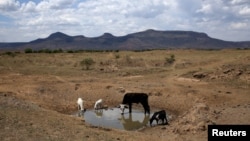The United Nations Children’s Fund is warning that up to 11 million children in east and southern Africa are at risk from hunger, disease and water shortages as a result of this year’s strengthening El Niño weather phenomenon. Kenya and Uganda are bracing for floods, while South Africa and Malawi are already grappling with drought.
Onesmus Ruirie, principal meteorologist at the Kenya Meteorological Department, remembers when El Niño hit in 1997 and 1998, years considered the strongest El Niño on record since 1950 when scientists began recording reliable observations.
“There was a lot of rain all over the whole country, which led to destruction of infrastructure, flooding, diseases, loss of lives. So '97 was a serious El Niño,” said Ruirie.
And 2015 is expected to be another “serious El Niño,” he said.
El Niño is a warming of the central and equatorial parts of the Pacific Ocean. It occurs roughly every two to seven years, and can have major effects on weather around the globe, according to Tom Di Liberto, a meteorologist at the National Oceanic and Atmospheric Administration (NOAA) in Washington, D.C.
“When you see this anomalous warming of the ocean temperatures, it can kind of shift around how the atmosphere works in the tropic, which can lead to a domino effect, affecting weather and climate patterns really far away from just the tropical Pacific Ocean,” he said.
Impact
During an El Niño event, east African countries tend to have heavy rainfall, while southern Africa, along with Australia and Indonesia, usually experiences dryness, even drought and wildfires.
“What happens is that during El Niño, the weather pattern changes and for East Africa, we have a very warm equatorial Indian Ocean. And if the Indian Ocean is very warm due to evaporation of the ocean water, we have that water blown to the continental East Africa and that is why you have a lot of rain in East Africa. But to the south, that denies them the moisture. So that tends to be dry in the southern Africa,” Ruirie explained.
But the predictions don't always come true. In 1997, for instance, expected dry conditions in southern Africa never materialized.
For all its potential for destruction, El Niño may bring some benefits too.
“Like in northeastern Kenya, it has been very dry. So we expect this rain. The community there can dig dams to harvest that water. We expect pasture to rejuvenate,” said Ruirie.
Di Liberto said this year could be the third strongest El Niño on record, but that determination cannot be made until early 2016, when all the data is analyzed.









